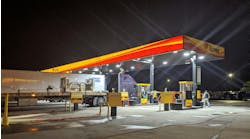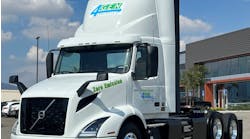Whether it's the roof of the trailer, or the wheels on the road, Tom Howard is focused on maximizing fuel efficiency for his fleet. The transportation systems manager for San Francisco-based Veritable Vegetable (VV) knows that every tenth of a mile per gallon counts and that translates into environmental benefits for the fleet of 22 power units that delivers organic fresh fruits and vegetables throughout California and parts of Colorado, New Mexico, Arizona, and Nevada.
Howard's task is made all that much easier thanks to the company's ownership, which has incorporated environmental responsibility into every aspect of VV.
EXECUTIVE SUPPORT
“The owners are very progressive, and if I can show a reasonable payback [they will support the initiative],” says Howard, who spends a majority of his time working to improve fleet efficiency. “A lot of freight fleets are very quick to look at the bottom line numbers, and many times the smaller fleets don't have the time to look at and analyze the numbers.”
Started in 1974, VV is said to be the nation's oldest distributor of organic produce. It purchases its products from nearly 350 different produce vendors, 75% of which is generated from customers located in California. The company, whose employee mix is 75% female, claims that 97% of its products are “certified organic,” so keeping the truck fleet as environmentally responsible as possible fits within the overall VV sustainability goals.
Through a variety of efforts, including the use of Xata Turnpike to improve routing, Howard says the fleet's long-haul tractors (Kenworth T660s with automatic transmissions) are now averaging about 6.8 mpg. Using a combination of grants, VV recently purchased four new Kenworth hybrids — three T370 tractors and one T270 straight truck. They join a fleet that also includes a pair of Sprinter vans, Freightliner M2s, and Peterbilt 385, 386, and 378 models. A fourth T370 hybrid is on order from NorCal Kenworth. In all, the fleet travels about 1.75 million mi. annually.
The hybrid straight truck is expected to reduce fuel consumption by 35.9 gals. per 1,000 mi. run, the company says. The average straight truck covers up to 60,000 mi./year. The fuel reduction on the hybrid tractors is expected to be 58.5 gals. per 1,000 mi. According to Howard, the average hybrid is costing the fleet about $37,000 more than a traditional diesel-only vehicle, but between the grants and tax credits available, as well as the fuel savings, a return on investment could be as soon as two years for each vehicle.
A TOTAL EFFORT
Hybrids, though, are just a fraction of what Howard has deployed across the fleet to improve fuel efficiency and reduce its environmental footprint. Idle shutdown technology throttles down the engines after 3 min., and the over-the-road tractors are equipped with battery-powered APUs and Webasto Product North America diesel heaters.
On the 17 trailers, which are mostly Utility Trailer model VS2RA, the company employs Thermo King SB-210 and Carrier Transicold Vector 6500 single temp refrigeration units. Howard says VV is also starting to add hybrid refrigeration units as well.
The company's tire program utilizes Bridgestone and Bandag fuel-efficient tire treads and includes Meritor automatic tire inflation systems that keep the trailer tires at 100 psi. Also, VV has installed a product called the Deflecktor on its trailer wheels. The Deflecktor is a wheel insert that reduces wind resistance.
SKIRTS, TOO
All the 48-ft. trailers are being equipped with ATDynamics aerodynamic side skirts, which provide a 3% improvement in fuel efficiency, translating to a yearly reduction of roughly 4,775 gals.
VV also tries to backhaul anything it can — from bulk produce to micro-brews — so its trailers are never running empty.
And proving that Howard really leaves no stone unturned, he says he is currently exploring the possibility of painting the roofs of the trailers with a special coating from Solar Cool Coatings in Glenside, PA. “The aluminum roof on top of the refrigeration trailer gets pretty hot and we run a lot in the desert areas of California,” he says, pointing out that Solar Cool claims a 20 deg. temperature reduction inside a trailer with the product.


